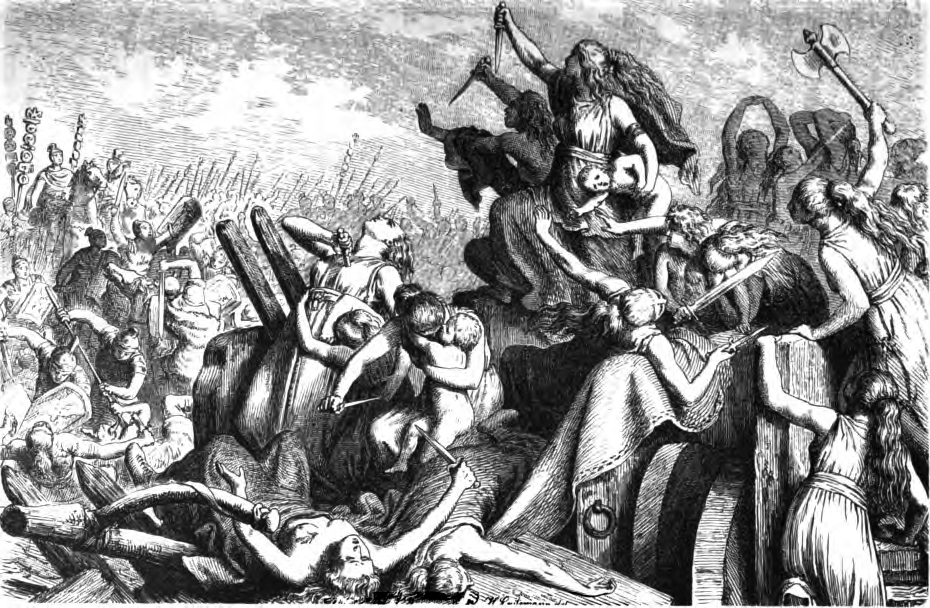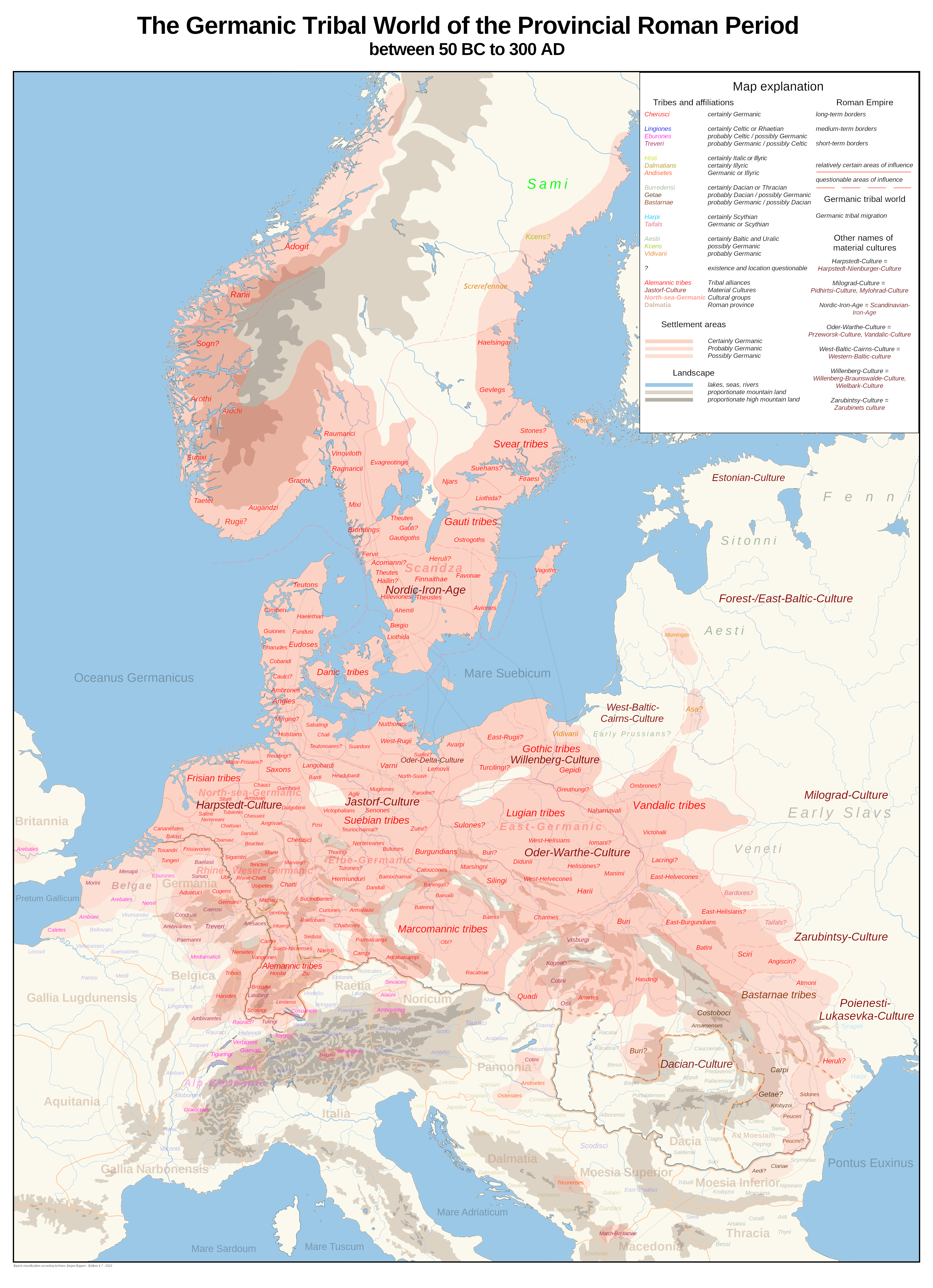|
Ingævones
The Ingaevones () or Ingvaeones () were a Germanic cultural group living in the Northern Germania along the North Sea coast in the areas of Jutland, Holstein, and Lower Saxony in classical antiquity. Tribes in this area included the Angles, Chauci, Saxons, and Jutes. The name is transmitted in two different forms in ancient sources: Tacitus provides the form , while Pliny the Elder has . Most scholars derive the name from the god or hero attested under the name Yngvi in later Norse sources, and thus believe Pliny's form is the original one. Hence the postulated common group of closely related dialects of the "Ingvaeones" is called Ingvaeonic or North Sea Germanic. Tacitus' source categorized the ''Ingaevones near the ocean'' as one of the three tribal groups descended from the three sons of Mannus, son of Tuisto, progenitor of all the Germanic peoples, the other two being the ''Irminones'' and the '' Istaevones''. According to the speculations of Rafael von Uslar, this t ... [...More Info...] [...Related Items...] OR: [Wikipedia] [Google] [Baidu] |
Istvaeones
The Istvaeones were a Germanic group of tribes living near the banks of the Rhine during the Roman Empire which reportedly shared a common culture and origin. The Istaevones were contrasted to neighbouring groups, the Ingaevones on the North Sea coast, and the Herminones, living inland of these groups. In linguistics, the term " Istvaeonic languages" is also sometimes used in discussions about the grouping of the northwestern West Germanic languages, consisting of Frankish and its descendants (principally Old Dutch) as well as several closely related historical dialects. Whether or not the Istvaeones spoke a Germanic language according to modern definitions, the theory proposes that their language indirectly influenced later Germanic languages in the area as a substrate. Nomenclature The term ''Istvaeonic'' is derived from a culturo-linguistic grouping of Germanic tribes mentioned by Tacitus, who used the spelling "''Istæuones''" in his ''Germania'', and Pliny the Elder, wh ... [...More Info...] [...Related Items...] OR: [Wikipedia] [Google] [Baidu] |
Germanic Dialects Ca
Germanic may refer to: * Germanic peoples, an ethno-linguistic group identified by their use of the Germanic languages ** List of ancient Germanic peoples and tribes * Germanic languages :* Proto-Germanic language, a reconstructed proto-language of all the Germanic languages * Germanic name * Germanic mythology, myths associated with Germanic paganism * Germanic religion (other) * SS ''Germanic'' (1874), a White Star Line steamship See also * Germania (other) * Germanus (other) * German (other) German(s) may refer to: * Germany, the country of the Germans and German things **Germania (Roman era) * Germans, citizens of Germany, people of German ancestry, or native speakers of the German language ** For citizenship in Germany, see also Ge ... * Germanicia Caesarea * * {{disambiguation Language and nationality disambiguation pages ... [...More Info...] [...Related Items...] OR: [Wikipedia] [Google] [Baidu] |
Tuisto
According to Tacitus's ''Germania'' (AD 98), Tuisto (or Tuisco) is the legendary divine ancestor of the Germanic peoples. The figure remains the subject of some scholarly discussion, largely focused upon etymological connections and comparisons to figures in later (particularly Norse) Germanic mythology. Etymology The ''Germania'' manuscript corpus contains two primary variant readings of the name. The most frequently occurring, Tuisto, is commonly connected to the Proto-Germanic root ''*twai'' – "two" and its derivative ''*twis'' – "twice" or "doubled", thus giving Tuisto the core meaning "double". Any assumption of a gender inference is entirely conjectural, as the tvia / tvis roots are also the roots of any number of other concepts / words in the Germanic languages. Take for instance the Germanic "twist", which, in all but the English has the primary meaning of "dispute / conflict". The second variant of the name, occurring originally in manuscript ''E'', reads Tuisco. ... [...More Info...] [...Related Items...] OR: [Wikipedia] [Google] [Baidu] |
Viking Age
The Viking Age (about ) was the period during the Middle Ages when Norsemen known as Vikings undertook large-scale raiding, colonising, conquest, and trading throughout Europe and reached North America. The Viking Age applies not only to their homeland of Scandinavia but also to any place significantly settled by North Germanic peoples, Scandinavians during the period. Although few of the Scandinavians of the Viking Age were Vikings in the sense of being engaged in piracy, they are often referred to as ''Vikings'' as well as ''Norsemen''. Voyaging by sea from their homelands in Denmark, Norway, and Sweden, the Norse people settled in the Viking activity in the British Isles, British Isles, History of Ireland (800–1169), Ireland, the Faroe Islands, Settlement of Iceland, Iceland, Norse settlements in Greenland, Greenland, History of Normandy, Normandy, and the Baltic Sea, Baltic coast and along the Trade route from the Varangians to the Greeks, Dnieper and Volga trade rout ... [...More Info...] [...Related Items...] OR: [Wikipedia] [Google] [Baidu] |
Ingwaz
Old Norse Yngvi , Old High German Ing/Ingwi and Old English Ing are names that relate to a theonym which appears to have been the older name for the god Freyr. Proto-Germanic Ingwaz was the legendary ancestor of the Ingaevones, or more accurately ''Ingvaeones'', and is also the reconstructed name of the Elder Futhark rune ᛜ and Anglo-Saxon rune ᛝ, representing '' ŋ''. Etymology Old Norse ''Yngvi'' as well as Old High German ''Inguin'' and Old English ''Ingƿine'' are all derived from the Proto-Germanic *Ingwaz. Sound changes in late-Proto-Germanic transformed *Ingwaz into *Ingwi(z) in the nominative case and *''Ingwin'' in the accusative case. His epithet * Fraujaz appears in Old Norse compounds ''Ingvifreyr'' and ''Ingunarfreyr''. In Beowulf we see Hrothgar called (OE) ''fréa inguina'', which means 'Lord of the Inguins', i.e. lord of the Ingvaeones, the 'friends of Ing'. This strongly indicates that the two deities, Ing and Freyr are indeed the same. However, it is a ... [...More Info...] [...Related Items...] OR: [Wikipedia] [Google] [Baidu] |
Blaeu 1645 - Germaniae Veteris Typus , a surname
{{disambiguation, surname ...
Blaeu is the name of * Willem Blaeu (1571–1638), Dutch cartographer and father of Joan Blaeu * Joan Blaeu (1596–1673), Dutch cartographer and son of Willem Blaeu * ''Blaeu Atlas of Scotland'', by Joan Blaeu, published in 1654 * ''Atlas Blaeu'' or ''Atlas Maior'', by Joan Blaeu, published in 1635 * ''Stedenboek Blaeu'' or '' Toonneel der Steeden'', by Joan Blaeu, published in 1649 See also * Blaauw Blaauw () is a Dutch language, Dutch surname. It is an archaic spelling of modern Dutch ''blauw'', meaning ''blue''. This may have referred to the pale skin, the eyes, or the clothes of the original bearer of the name or the surname may be metonymic ... [...More Info...] [...Related Items...] OR: [Wikipedia] [Google] [Baidu] |
Teutons
The Teutons (, ; ) were an ancient northern European tribe mentioned by Roman authors. The Teutons are best known for their participation, together with the Cimbri and other groups, in the Cimbrian War with the Roman Republic in the late second century BC. Some generations later, Julius Caesar compared them to the Germanic peoples of his own time, and used this term for all northern peoples located east of the Rhine. Later Roman authors followed his identification. However, there is no direct evidence about whether or not they spoke a Germanic language. Evidence such as the tribal name, and the names of their rulers, as they were written up by Roman historians, indicates a strong influence from Celtic languages. On the other hand, the indications that classical authors gave about the homeland of the Teutones is considered by many scholars to show that they lived in an area associated with early Germanic languages, and not in an area associated with Celtic languages. Name Th ... [...More Info...] [...Related Items...] OR: [Wikipedia] [Google] [Baidu] |
Cimbri
The Cimbri (, ; ) were an ancient tribe in Europe. Ancient authors described them variously as a Celtic, Gaulish, Germanic, or even Cimmerian people. Several ancient sources indicate that they lived in Jutland, which in some classical texts was called the Cimbrian peninsula. There is no direct evidence for the language they spoke, though some scholars argue that it was a Germanic language, while others argue that it was Celtic. Together with the Teutones and the Ambrones, they fought the Roman Republic between 113 and 101 BC during the Cimbrian War. The Cimbri were initially successful, particularly at the Battle of Arausio, in which a large Roman army was routed. They then raided large areas in Gaul and Hispania. In 101 BC, during an attempted invasion of the Italian peninsula, the Cimbri were decisively defeated at the Battle of Vercellae by Gaius Marius, and their king, Boiorix, was killed. Some of the surviving captives are reported to have been among the rebellious gl ... [...More Info...] [...Related Items...] OR: [Wikipedia] [Google] [Baidu] |
Bastarnae
The Bastarnae, Bastarni or Basternae, also known as the Peuci or Peucini, were an ancient people who are known from Greek and Roman records to have inhabited areas north and east of the Carpathian Mountains between about 300 BC and about 300 AD, stretching in an ark from the sources of the Vistula in present-day Poland and Slovakia, to the Lower Danube, and including all or most of present-day Moldava. The Peucini were sometimes described as a subtribe, who settled the Peuke Island in the Danube Delta, but apparently due to their importance their name was sometimes used for the Bastarnae as a whole. Near the sources of the Vistula another part of the Bastarnae were the Sidones, while the Atmoni, another tribe of the Bastarnae are only mentioned in one listing by Strabo. The earliest Graeco-Roman historians to refer to the Bastarnae imply that they were culturally La Tène culture, Celtic. Also consistent with connections to the cultures to their west, later Roman-era sources stat ... [...More Info...] [...Related Items...] OR: [Wikipedia] [Google] [Baidu] |
Vandals
The Vandals were a Germanic people who were first reported in the written records as inhabitants of what is now Poland, during the period of the Roman Empire. Much later, in the fifth century, a group of Vandals led by kings established Vandal kingdoms first within the Iberian Peninsula, and then in the western Mediterranean islands, and North Africa. Archaeologists associate the early Vandals with the Przeworsk culture, which has led to some authors equating them to the Lugii, who were another group of Germanic peoples associated with that same archaeological culture and region. Expanding into Dacia during the Marcomannic Wars and to Pannonia during the Crisis of the Third Century, the Vandals were confined to Pannonia by the Goths around 330 AD, where they received permission to settle from Constantine the Great. Around 400, raids by the Huns from the east forced many Germanic tribes to migrate west into the territory of the Roman Empire and, fearing that they might be ... [...More Info...] [...Related Items...] OR: [Wikipedia] [Google] [Baidu] |
Natural History (Pliny)
The ''Natural History'' () is a Latin work by Pliny the Elder. The largest single work to have survived from the Roman Empire to the modern day, the ''Natural History'' compiles information gleaned from other ancient authors. Despite the work's title, its subject area is not limited to what is today understood by natural history; Pliny himself defines his scope as "the natural world, or life". It is encyclopedic in scope, but its structure is not like that of a modern encyclopedia. It is the only work by Pliny to have survived, and the last that he published. He published the first 10 books in AD 77, but had not made a final revision of the remainder at the time of Pliny the Elder#Death, his death during the Eruption of Mount Vesuvius in 79 AD, AD 79 eruption of Vesuvius. The rest was published posthumously by Pliny's nephew, Pliny the Younger. The work is divided into 37 books, organised into 10 volumes. These cover topics including astronomy, mathematics, geography, ethn ... [...More Info...] [...Related Items...] OR: [Wikipedia] [Google] [Baidu] |






